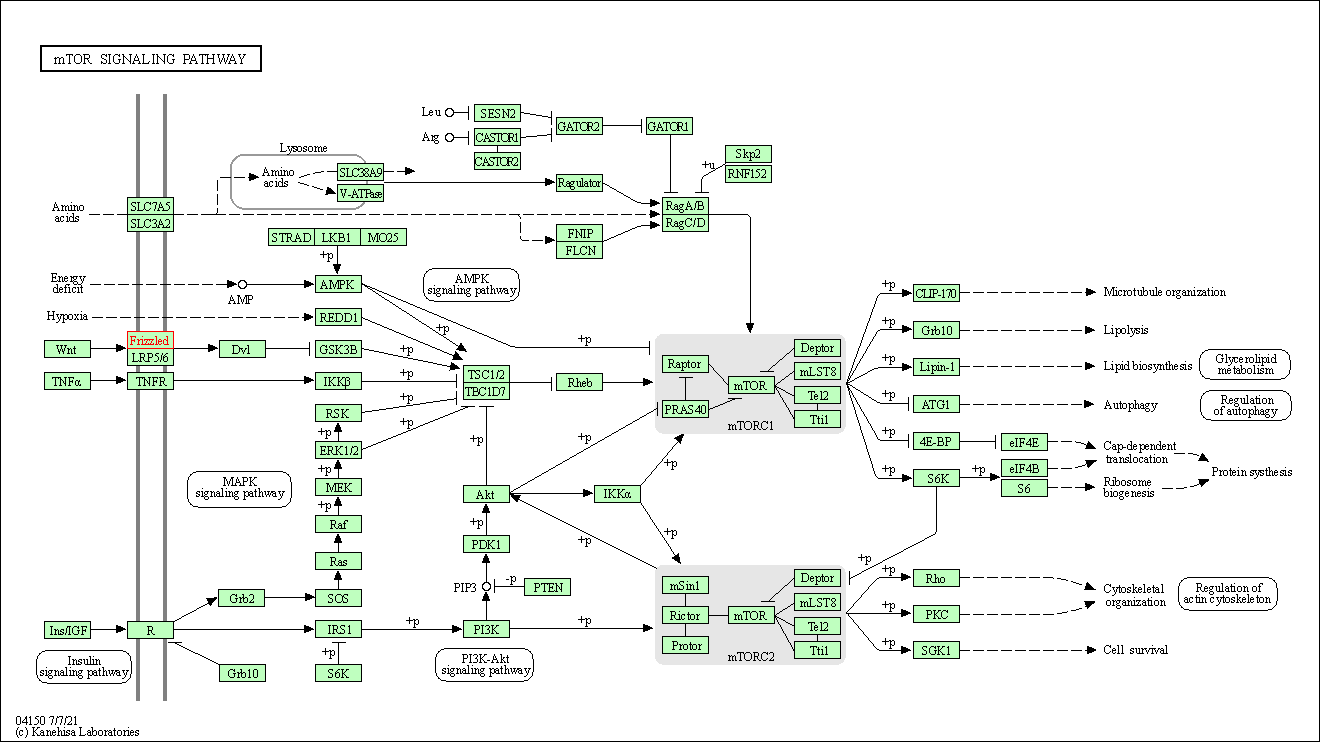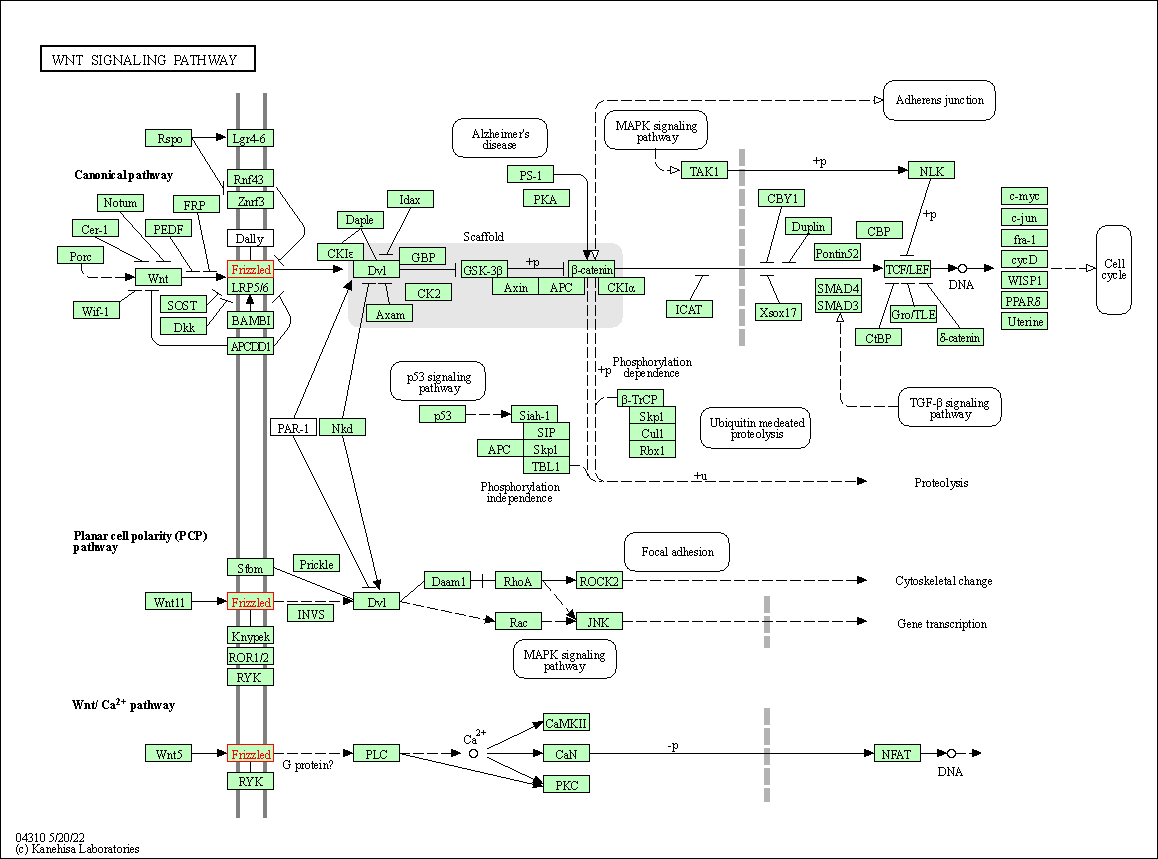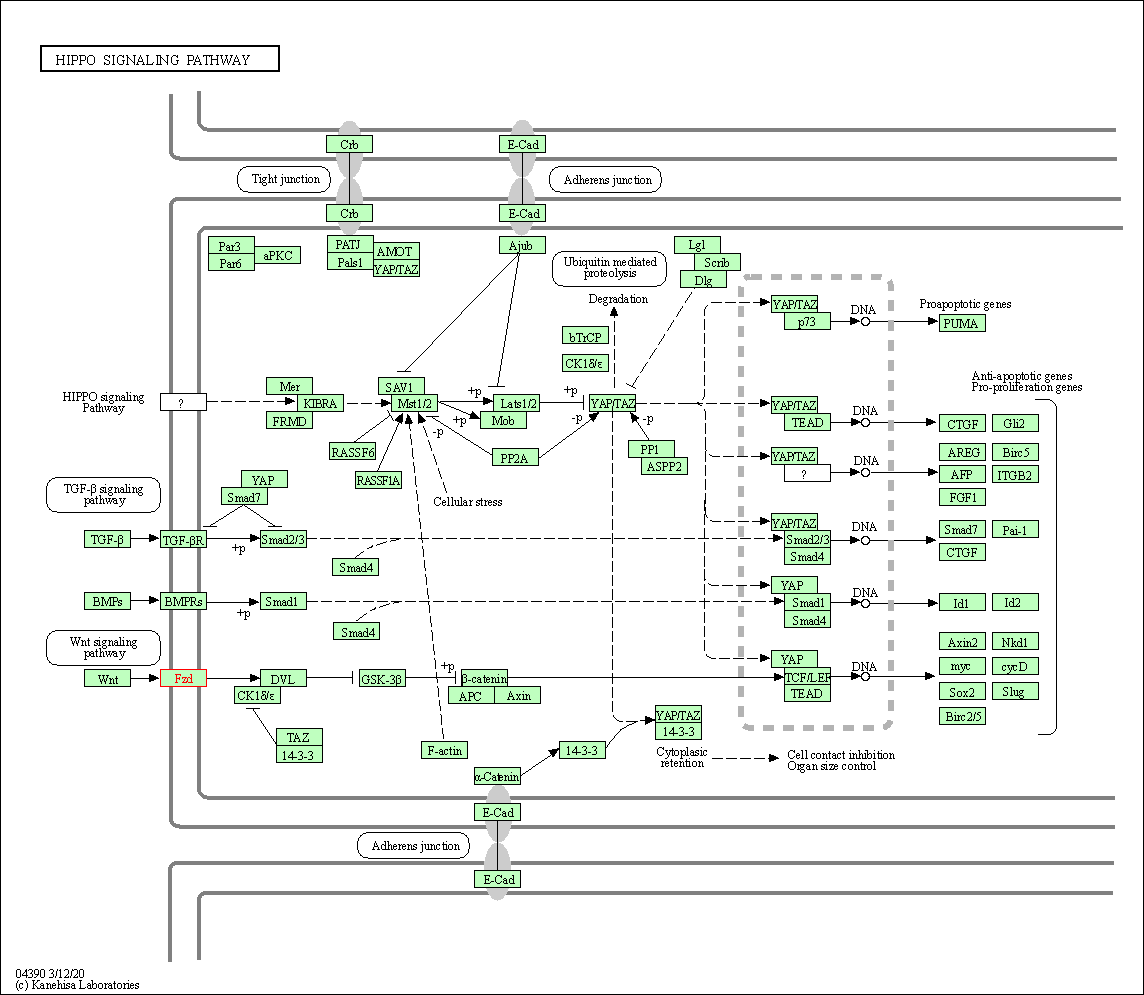Target Information
| Target General Information | Top | |||||
|---|---|---|---|---|---|---|
| Target ID |
T39797
(Former ID: TTDI02075)
|
|||||
| Target Name |
Frizzled-7 receptor (FZD7)
|
|||||
| Synonyms |
hFz7; FzE3; Fz7; Fz-7; Frizzled7; Frizzled-7
Click to Show/Hide
|
|||||
| Gene Name |
FZD7
|
|||||
| Target Type |
Clinical trial target
|
[1] | ||||
| Disease | [+] 1 Target-related Diseases | + | ||||
| 1 | Solid tumour/cancer [ICD-11: 2A00-2F9Z] | |||||
| Function |
Most of frizzled receptors are coupled to the beta-catenin canonical signaling pathway, which leads to the activation of disheveled proteins, inhibition of GSK-3 kinase, nuclear accumulation of beta-catenin and activation of Wnt target genes. A second signaling pathway involving PKC and calcium fluxes has been seen for some family members, but it is not yet clear if it represents a distinct pathway or if it can be integrated in the canonical pathway, as PKC seems to be required for Wnt-mediated inactivation of GSK-3 kinase. Both pathways seem to involve interactions with G-proteins. May be involved in transduction and intercellular transmission of polarity information during tissue morphogenesis and/or in differentiated tissues. Receptor for Wnt proteins.
Click to Show/Hide
|
|||||
| BioChemical Class |
GPCR frizzled
|
|||||
| UniProt ID | ||||||
| Sequence |
MRDPGAAAPLSSLGLCALVLALLGALSAGAGAQPYHGEKGISVPDHGFCQPISIPLCTDI
AYNQTILPNLLGHTNQEDAGLEVHQFYPLVKVQCSPELRFFLCSMYAPVCTVLDQAIPPC RSLCERARQGCEALMNKFGFQWPERLRCENFPVHGAGEICVGQNTSDGSGGPGGGPTAYP TAPYLPDLPFTALPPGASDGRGRPAFPFSCPRQLKVPPYLGYRFLGERDCGAPCEPGRAN GLMYFKEEERRFARLWVGVWSVLCCASTLFTVLTYLVDMRRFSYPERPIIFLSGCYFMVA VAHVAGFLLEDRAVCVERFSDDGYRTVAQGTKKEGCTILFMVLYFFGMASSIWWVILSLT WFLAAGMKWGHEAIEANSQYFHLAAWAVPAVKTITILAMGQVDGDLLSGVCYVGLSSVDA LRGFVLAPLFVYLFIGTSFLLAGFVSLFRIRTIMKHDGTKTEKLEKLMVRIGVFSVLYTV PATIVLACYFYEQAFREHWERTWLLQTCKSYAVPCPPGHFPPMSPDFTVFMIKYLMTMIV GITTGFWIWSGKTLQSWRRFYHRLSHSSKGETAV Click to Show/Hide
|
|||||
| 3D Structure | Click to Show 3D Structure of This Target | AlphaFold | ||||
| HIT2.0 ID | T79BDP | |||||
| Drugs and Modes of Action | Top | |||||
|---|---|---|---|---|---|---|
| Clinical Trial Drug(s) | [+] 1 Clinical Trial Drugs | + | ||||
| 1 | OMP-18R5 | Drug Info | Phase 1 | Solid tumour/cancer | [2] | |
| Mode of Action | [+] 1 Modes of Action | + | ||||
| Inhibitor | [+] 1 Inhibitor drugs | + | ||||
| 1 | OMP-18R5 | Drug Info | [1] | |||
| Cell-based Target Expression Variations | Top | |||||
|---|---|---|---|---|---|---|
| Cell-based Target Expression Variations | ||||||
| Drug Binding Sites of Target | Top | |||||
|---|---|---|---|---|---|---|
| Ligand Name: 4,5,-IP2 | Ligand Info | |||||
| Structure Description | Crystal structure of the syntenin PDZ1 and PDZ2 tandem in complex with the Frizzled 7 C-terminal fragment and PIP2 | PDB:4Z33 | ||||
| Method | X-ray diffraction | Resolution | 2.45 Å | Mutation | No | [3] |
| PDB Sequence |
KGETAV
|
|||||
|
|
||||||
| Ligand Name: Nervonic acid | Ligand Info | |||||
| Structure Description | Crystal structure of Frizzled 7 CRD in complex with C24 fatty acid | PDB:5URV | ||||
| Method | X-ray diffraction | Resolution | 2.20 Å | Mutation | No | [4] |
| PDB Sequence |
HGFCQPISIP
25 LCTDIAYNQT35 ILPNLLGHTN45 QEDAGLEVHQ55 FYPLVKVQCS65 PELRFFLCSM 75 YAPVCTVLDQ85 AIPPCRSLCE95 RARQGCEALM105 NKFGFQWPER115 LRCENFPVHG 125 AGEICVGQ
|
|||||
|
|
||||||
| Click to View More Binding Site Information of This Target with Different Ligands | ||||||
| Different Human System Profiles of Target | Top |
|---|---|
|
Human Similarity Proteins
of target is determined by comparing the sequence similarity of all human proteins with the target based on BLAST. The similarity proteins for a target are defined as the proteins with E-value < 0.005 and outside the protein families of the target.
A target that has fewer human similarity proteins outside its family is commonly regarded to possess a greater capacity to avoid undesired interactions and thus increase the possibility of finding successful drugs
(Brief Bioinform, 21: 649-662, 2020).
Human Tissue Distribution
of target is determined from a proteomics study that quantified more than 12,000 genes across 32 normal human tissues. Tissue Specificity (TS) score was used to define the enrichment of target across tissues.
The distribution of targets among different tissues or organs need to be taken into consideration when assessing the target druggability, as it is generally accepted that the wider the target distribution, the greater the concern over potential adverse effects
(Nat Rev Drug Discov, 20: 64-81, 2021).
Human Pathway Affiliation
of target is determined by the life-essential pathways provided on KEGG database. The target-affiliated pathways were defined based on the following two criteria (a) the pathways of the studied target should be life-essential for both healthy individuals and patients, and (b) the studied target should occupy an upstream position in the pathways and therefore had the ability to regulate biological function.
Targets involved in a fewer pathways have greater likelihood to be successfully developed, while those associated with more human pathways increase the chance of undesirable interferences with other human processes
(Pharmacol Rev, 58: 259-279, 2006).
Biological Network Descriptors
of target is determined based on a human protein-protein interactions (PPI) network consisting of 9,309 proteins and 52,713 PPIs, which were with a high confidence score of ≥ 0.95 collected from STRING database.
The network properties of targets based on protein-protein interactions (PPIs) have been widely adopted for the assessment of target’s druggability. Proteins with high node degree tend to have a high impact on network function through multiple interactions, while proteins with high betweenness centrality are regarded to be central for communication in interaction networks and regulate the flow of signaling information
(Front Pharmacol, 9, 1245, 2018;
Curr Opin Struct Biol. 44:134-142, 2017).
Human Similarity Proteins
Human Tissue Distribution
Human Pathway Affiliation
Biological Network Descriptors
|
|
|
There is no similarity protein (E value < 0.005) for this target
|
|
Note:
If a protein has TS (tissue specficity) scores at least in one tissue >= 2.5, this protein is called tissue-enriched (including tissue-enriched-but-not-specific and tissue-specific). In the plots, the vertical lines are at thresholds 2.5 and 4.
|
| KEGG Pathway | Pathway ID | Affiliated Target | Pathway Map |
|---|---|---|---|
| mTOR signaling pathway | hsa04150 | Affiliated Target |

|
| Class: Environmental Information Processing => Signal transduction | Pathway Hierarchy | ||
| Wnt signaling pathway | hsa04310 | Affiliated Target |

|
| Class: Environmental Information Processing => Signal transduction | Pathway Hierarchy | ||
| Hippo signaling pathway | hsa04390 | Affiliated Target |

|
| Class: Environmental Information Processing => Signal transduction | Pathway Hierarchy | ||
| Signaling pathways regulating pluripotency of stem cells | hsa04550 | Affiliated Target |

|
| Class: Cellular Processes => Cellular community - eukaryotes | Pathway Hierarchy | ||
| Melanogenesis | hsa04916 | Affiliated Target |

|
| Class: Organismal Systems => Endocrine system | Pathway Hierarchy | ||
| Degree | 11 | Degree centrality | 1.18E-03 | Betweenness centrality | 2.35E-04 |
|---|---|---|---|---|---|
| Closeness centrality | 2.06E-01 | Radiality | 1.36E+01 | Clustering coefficient | 3.82E-01 |
| Neighborhood connectivity | 2.08E+01 | Topological coefficient | 2.00E-01 | Eccentricity | 12 |
| Download | Click to Download the Full PPI Network of This Target | ||||
| Chemical Structure based Activity Landscape of Target | Top |
|---|---|
| Target Regulators | Top | |||||
|---|---|---|---|---|---|---|
| Target-regulating microRNAs | ||||||
| Target Affiliated Biological Pathways | Top | |||||
|---|---|---|---|---|---|---|
| KEGG Pathway | [+] 8 KEGG Pathways | + | ||||
| 1 | Wnt signaling pathway | |||||
| 2 | Hippo signaling pathway | |||||
| 3 | Signaling pathways regulating pluripotency of stem cells | |||||
| 4 | Melanogenesis | |||||
| 5 | HTLV-I infection | |||||
| 6 | Pathways in cancer | |||||
| 7 | Proteoglycans in cancer | |||||
| 8 | Basal cell carcinoma | |||||
| NetPath Pathway | [+] 1 NetPath Pathways | + | ||||
| 1 | TGF_beta_Receptor Signaling Pathway | |||||
| Panther Pathway | [+] 3 Panther Pathways | + | ||||
| 1 | Alzheimer disease-presenilin pathway | |||||
| 2 | Cadherin signaling pathway | |||||
| 3 | Wnt signaling pathway | |||||
| PID Pathway | [+] 3 PID Pathways | + | ||||
| 1 | Noncanonical Wnt signaling pathway | |||||
| 2 | Wnt signaling network | |||||
| 3 | Syndecan-4-mediated signaling events | |||||
| Reactome | [+] 2 Reactome Pathways | + | ||||
| 1 | Class B/2 (Secretin family receptors) | |||||
| 2 | PCP/CE pathway | |||||
| WikiPathways | [+] 2 WikiPathways | + | ||||
| 1 | Wnt Signaling Pathway | |||||
| 2 | Wnt Signaling Pathway and Pluripotency | |||||
| References | Top | |||||
|---|---|---|---|---|---|---|
| REF 1 | Wnt pathway inhibition via the targeting of Frizzled receptors results in decreased growth and tumorigenicity of human tumors. Proc Natl Acad Sci U S A. 2012 Jul 17;109(29):11717-22. | |||||
| REF 2 | ClinicalTrials.gov (NCT01345201) A Dose Escalation Study of OMP-18R5 in Subjects With Solid Tumors. U.S. National Institutes of Health. | |||||
| REF 3 | Crystal structure of the syntenin PDZ1 and PDZ2 tandem in complex with the Frizzled 7 C-terminal fragment and PIP2 | |||||
| REF 4 | Unsaturated fatty acyl recognition by Frizzled receptors mediates dimerization upon Wnt ligand binding. Proc Natl Acad Sci U S A. 2017 Apr 18;114(16):4147-4152. | |||||
If You Find Any Error in Data or Bug in Web Service, Please Kindly Report It to Dr. Zhou and Dr. Zhang.

